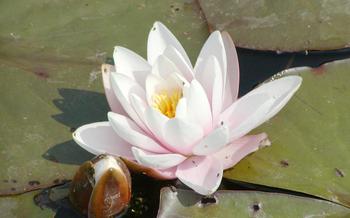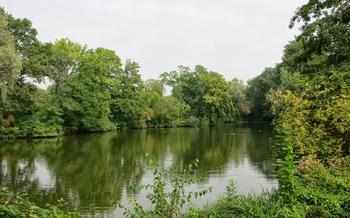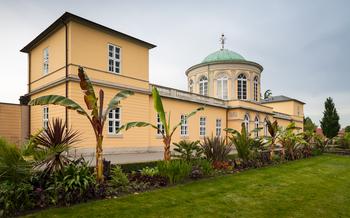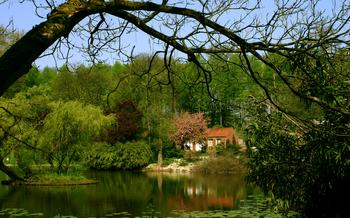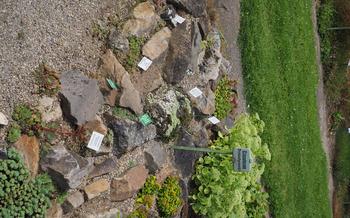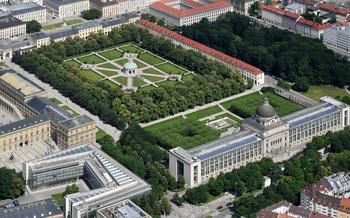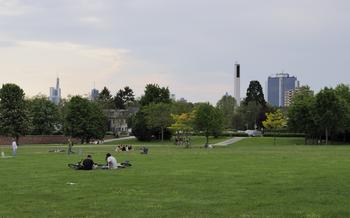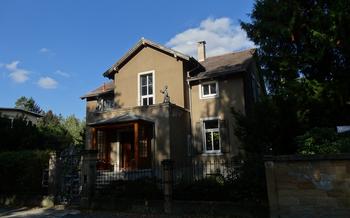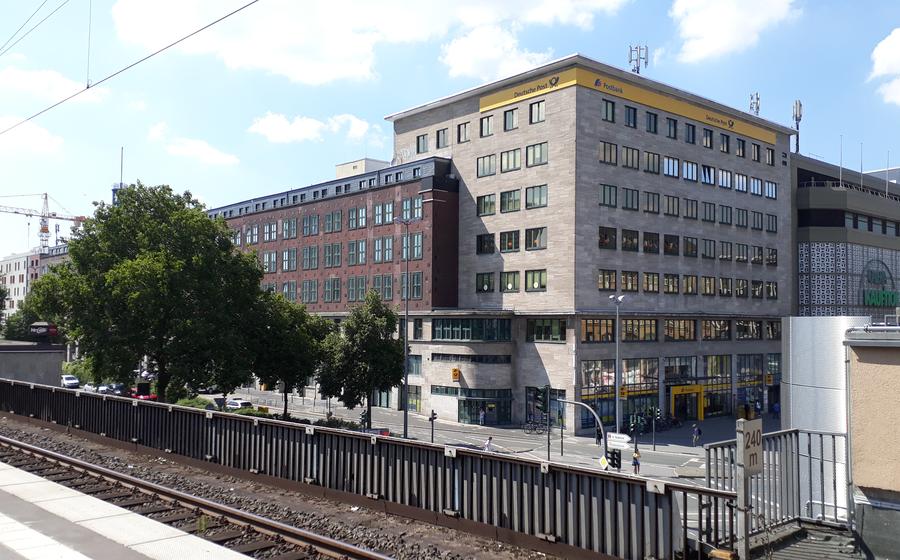
Bergerhausen Monastery Garden
- A Journey Through History
- Nature's Haven: The Garden's Landscape
- Art and Inspiration: Sculptures and Installations
- Thematic Gardens: A Path of Discovery
- The Rose Garden: A Symphony of Fragrance
- The Sensory Garden: Engaging All Senses
- The Labyrinth: A Path of Reflection
- The Pond and Water Features: A Haven for Wildlife
- The Bee Garden: A Buzzing World
- The Children's Garden: A Place for Play and Learning
- Events and Workshops: Engaging Experiences
- Accessibility and Facilities: A Welcoming Space
- Guided Tours: Unveiling Hidden Stories
- Picnics and Refreshments: A Culinary Delight
- Insider Tip: Hidden Gems and Secret Spots
A Journey Through History
The Bergerhausen Monastery Garden, nestled in the heart of Essen, Germany, is a testament to the region's rich cultural heritage. Its roots can be traced back to the 12th century when the Cistercian monks established a monastery on this site. The garden was initially used for growing herbs and vegetables to sustain the monks and provide medicinal remedies. Over the centuries, it evolved into a place of contemplation, beauty, and horticultural excellence.
In the 16th century, the monastery underwent significant renovations and expansions, resulting in the construction of a new cloister and the enlargement of the garden. This period marked the introduction of ornamental plants, such as roses, tulips, and lilies, transforming the garden into a vibrant and colorful spectacle. The monks' meticulous care and dedication to horticulture laid the foundation for the garden's future significance.
During the secularization of monasteries in the 19th century, the Bergerhausen Monastery was dissolved, and the garden fell into disrepair. However, in the early 20th century, a group of passionate citizens recognized its historical and cultural value and initiated its restoration. Through their efforts, the garden was revived, and its former glory was meticulously recreated.
Today, the Bergerhausen Monastery Garden stands as a living testament to the region's rich history, blending medieval charm with modern horticultural practices. Visitors can wander through its tranquil paths, marvel at its diverse flora, and experience a sense of serenity that has been cultivated for centuries. The garden's significance extends beyond its aesthetic beauty, as it serves as a reminder of the enduring legacy of the Cistercian monks and their dedication to cultivating both the land and the spirit.
Nature's Haven: The Garden's Landscape
The Bergerhausen Monastery Garden is a haven for nature enthusiasts, showcasing a diverse array of plant species meticulously arranged to create a harmonious landscape. The garden's rich biodiversity contributes to the preservation of local flora, providing a sanctuary for native plants and attracting a variety of wildlife.
Take a leisurely stroll through the garden, and you'll be greeted by vibrant displays of seasonal blooms. Spring brings forth a kaleidoscope of colors as tulips, daffodils, and hyacinths paint the landscape with their vibrant hues. Summer transforms the garden into a fragrant oasis, with roses, lavender, and honeysuckle filling the air with their heady scents. Autumn's arrival brings a touch of golden warmth as the leaves of deciduous trees turn into shades of amber, crimson, and ochre.
The garden's microclimate creates an ideal environment for a wide range of plant life to thrive. Sheltered from the harsh winds by surrounding buildings, the garden enjoys a relatively mild climate, allowing for the cultivation of more delicate and exotic species. The careful positioning of trees and shrubs creates pockets of shade and sun, catering to the specific needs of different plants.
Be sure to keep an eye out for rare and endangered species, including the delicate lady's slipper orchid, the stately maidenhair fern, and the elusive wood anemone. These botanical treasures add an extra layer of intrigue and fascination to the garden's landscape, making each visit a unique and memorable experience.
Art and Inspiration: Sculptures and Installations
The Bergerhausen Monastery Garden is not just a haven for nature enthusiasts; it is also a gallery of captivating sculptures and installations that add a layer of artistic expression to the garden's landscape. These artworks, created by talented local and international artists, are carefully placed throughout the garden, harmonizing with the natural surroundings and inviting visitors to engage in a dialogue between art and nature.
Theoretical: The sculptures and installations in the garden are not mere decorations; they carry profound meanings and symbolism that enhance the visitor's experience. Some sculptures evoke historical events or figures, paying homage to the garden's rich past. Others explore contemporary themes such as environmental conservation, human emotions, or the relationship between humanity and nature.
Practical: Among the must-see sculptures is the striking "Dancing Faun" by the renowned artist, Alexander Archipenko. This bronze sculpture captures the essence of movement and joy, its graceful lines and dynamic pose creating a sense of vitality amidst the tranquil garden. Another highlight is the whimsical "Garden of Mirrors" by Olafur Eliasson, a series of reflective panels that create an immersive experience, blurring the boundaries between reality and illusion.
Anecdotal: During my visit to the garden, I was particularly drawn to the "Whispering Trees" by Janet Cardiff. This interactive installation consists of a series of speakers hidden among the trees, playing soft whispers and murmurs that seem to come from the trees themselves. The effect is both enchanting and eerie, creating a sense of mystery and wonder as if the garden is alive with secrets.
Informative: The materials and techniques used by the artists vary widely, adding to the diversity of the garden's artistic expressions. From traditional bronze and stone sculptures to contemporary installations using recycled materials or interactive technologies, the garden showcases a range of artistic styles and mediums. The artists' backgrounds and inspirations are also diverse, reflecting the international scope of the garden's artistic vision.
Thematic Gardens: A Path of Discovery
The Bergerhausen Monastery Garden boasts a collection of captivating thematic gardens that transport visitors to diverse corners of the plant kingdom. Each garden is meticulously designed to showcase unique plant species and evoke distinct sensory experiences.
Discover the Herb Garden: Embark on a culinary and aromatic journey through the herb garden, where fragrant herbs like lavender, mint, and basil fill the air with their heady scents. Learn about their medicinal and culinary uses, and perhaps even pick a few to enhance your cooking creations.
Explore the Shade Garden: Escape the summer heat and find respite in the tranquil shade garden. Lush ferns, hostas, and hellebores thrive in the dappled light, creating a verdant oasis of tranquility. Discover the secrets of shade gardening and take inspiration for your own shady retreats.
Unravel the Rock Garden: Step into a miniature world of alpine plants in the rock garden. Witness the resilience of these hardy species as they cling to rocky outcrops and crevices, defying the elements. Learn about the unique adaptations that allow them to flourish in such harsh conditions.
Immerse Yourself in the Woodland Garden: Wander through the woodland garden, where towering trees cast shadows on a carpet of wildflowers and ferns. Observe the intricate relationships between plants and wildlife, and discover the delicate balance that sustains this miniature ecosystem.
Awaken Your Senses in the Sensory Garden: Engage all your senses in the sensory garden, designed to stimulate touch, smell, taste, and sound. Experience the velvety softness of lamb's ear leaves, inhale the intoxicating fragrance of roses, savor the tangy sweetness of edible flowers, and listen to the gentle rustling of wind through the bamboo grove.
As you stroll through these thematic gardens, allow yourself to be captivated by the beauty and diversity of the plant world. Each garden offers a unique perspective on the wonders of nature, inviting you to discover new favorites and deepen your appreciation for the intricacies of the natural world.
The Rose Garden: A Symphony of Fragrance
The rose garden at the Bergerhausen Monastery Garden is a true masterpiece, a symphony of colors, fragrances, and elegance. With over 2,000 varieties of roses, this enchanting garden is a haven for rose enthusiasts and nature lovers alike.
Strolling through the meticulously manicured paths, visitors are greeted by an array of roses in every hue imaginable, from the classic red and white to the more exotic shades of purple, yellow, and orange. The air is filled with a heady fragrance, a sweet perfume that lingers long after you leave the garden.
Highlights of the rose garden include the historic roses, which have been carefully preserved and nurtured over the years. These roses, with their delicate petals and old-fashioned charm, offer a glimpse into the past. The modern roses, on the other hand, showcase the latest achievements in rose breeding, with their vibrant colors, large blooms, and disease resistance.
The best time to visit the rose garden is during the peak blooming season, which typically runs from June to July. This is when the roses are in full bloom, their petals unfurling to reveal their velvety softness and intricate patterns. The garden also hosts special events and workshops during this time, such as rose shows, guided tours, and rose-themed workshops.
The Sensory Garden: Engaging All Senses
Theoretical:
The sensory garden at the Bergerhausen Monastery Garden is a unique and immersive experience that engages multiple senses, offering a profound connection with nature. Designed to stimulate touch, smell, taste, and sound, this garden is a haven for those seeking a multisensory journey. Visitors are invited to touch the velvety leaves of plants, inhale the heady fragrance of blooming flowers, savor the taste of edible herbs and fruits, and listen to the calming sounds of water features and rustling leaves.
Practical:
To fully immerse oneself in the sensory experience, it is essential to engage all senses actively. Start by touching the plants gently, feeling their different textures and shapes. Take deep breaths and inhale the aromatic scents of the flowers and herbs. Nibble on edible leaves or fruits, savoring their unique flavors. Finally, listen attentively to the sounds of the garden, from the gentle trickling of water to the chirping of birds.
Anecdotal:
In the sensory garden, I experienced a profound connection with nature that transcended the visual. I remember touching the soft petals of a rose, feeling its delicate texture against my skin. The heady fragrance of lavender filled the air, transporting me to a field of purple blooms. I plucked a ripe strawberry and popped it into my mouth, savoring its sweet and tangy flavor. The gentle sound of water flowing from a fountain created a tranquil ambiance, soothing my mind and spirit.
Informative:
Sensory gardens offer therapeutic benefits, stimulating the senses and promoting overall well-being. The tactile experience of touching plants can reduce stress and anxiety, while the scents of flowers and herbs can have calming and uplifting effects. Tasting edible plants can provide a deeper appreciation for the diverse flavors of nature. The sounds of water and wind create a serene atmosphere, promoting relaxation and mindfulness.
The Labyrinth: A Path of Reflection
In the heart of the Bergerhausen Monastery Garden, a mysterious labyrinth beckons visitors to embark on a journey of self-discovery. Inspired by ancient traditions, this intricate maze invites you to wander through its winding paths, each turn revealing new perspectives and insights. As you trace the labyrinth's course, you'll find yourself slowing down, your thoughts quieting, and a sense of tranquility enveloping you.
The labyrinth is not just a physical puzzle to be solved; it's a metaphor for the journey of life, with its twists, turns, and unexpected detours. As you navigate its meandering paths, you'll have the opportunity to reflect on your own life's journey, your triumphs and challenges, your hopes and dreams. The labyrinth provides a space for contemplation, introspection, and a deeper connection with your inner self.
Take your time as you walk the labyrinth's path, allowing yourself to be fully present in the moment. Let go of distractions and embrace the opportunity for self-reflection. Whether you choose to walk the labyrinth alone or in the company of others, the experience is sure to be transformative and deeply personal.
The Pond and Water Features: A Haven for Wildlife
The Bergerhausen Monastery Garden boasts a series of interconnected ponds and water features that create a vibrant and diverse ecosystem. These serene water bodies are not just visually pleasing but also serve as a crucial habitat for a variety of wildlife species.
As you approach the ponds, the gentle sound of water trickling and the chorus of frogs create a tranquil ambiance. The crystal-clear water reflects the lush greenery and colorful blooms of the surrounding plants, creating a picturesque scene.
Take a moment to observe the diverse aquatic life that calls these ponds home. Dragonflies and damselflies dance gracefully over the water's surface, their iridescent wings shimmering in the sunlight. Frogs and toads leap from lily pads, creating ripples that disturb the tranquil water.
Look closely, and you might spot a shy water vole scurrying along the bank, its beady eyes darting around in search of food. The ponds are also home to various fish species, including carp, tench, and roach, which can be seen swimming lazily among the aquatic plants.
The water features in the garden not only provide a habitat for wildlife but also contribute to the garden's microclimate, increasing humidity and providing a cooler environment for the plants and animals that thrive here.
As you stroll along the pathways that meander around the ponds, take a deep breath and inhale the fresh, invigorating air. The sound of water and the vibrant colors of the flora and fauna create a truly immersive experience, allowing you to connect with nature and appreciate the delicate balance of life within this harmonious ecosystem.
The Bee Garden: A Buzzing World
Theoretical
The bee garden, a captivating haven nestled within the Bergerhausen Monastery Garden, stands as a testament to the crucial role bees play in our environment and the garden's ecosystem. These industrious creatures, often overlooked, are essential pollinators, contributing significantly to the reproduction of countless plant species. Their intricate social structure and remarkable foraging behavior make them fascinating subjects of study and admiration.
Practical
As you venture into the bee garden, prepare to be greeted by a symphony of buzzing sounds, a testament to the bees' tireless work. Observe the various species that call this garden their home, from the common honeybee to the solitary bee, each playing a vital role in the pollination process. The best time to witness their activity is during the warmer months, when the garden bursts into bloom and the bees are at their busiest.
Anecdotal
One unforgettable experience in the bee garden was observing a honeybee colony at work. I marveled at their organized chaos, as they darted in and out of their hive, carrying pollen and nectar to sustain their community. The intricate dance they performed, communicating with each other through subtle movements, was a mesmerizing sight.
Informative
Beekeeping, the practice of caring for honeybees, has a long and rich tradition in the region. The bee garden provides a glimpse into this fascinating craft, showcasing traditional beekeeping techniques and the importance of preserving these vital pollinators. Visitors can learn about honey production, the threats facing bees, and the conservation efforts underway to protect these remarkable creatures.
The Children's Garden: A Place for Play and Learning
The Bergerhausen Monastery Garden is a place where children can not only have fun but also learn valuable lessons about nature, the environment, and themselves. The Children's Garden, a dedicated space within the larger garden, is designed specifically to foster exploration, curiosity, and hands-on learning.
With its colorful play areas, interactive elements, and educational activities, the Children's Garden is a paradise for young minds. Children can climb on the wooden structures, slide down the slides, and swing on the swings while engaging with the natural world around them. They can learn about the different plants and animals that inhabit the garden, explore the concepts of sustainability and conservation, and develop their creativity and imagination through art and play.
The garden's educational value is carefully considered in the design of the Children's Garden. Playful activities are intertwined with educational opportunities, allowing children to learn while they play. Interactive displays, games, and puzzles help them understand the importance of biodiversity, the role of insects in pollination, and the delicate balance of ecosystems.
The Children's Garden is not just a place for entertainment but also a place for personal growth and development. Through their experiences in the garden, children can develop their problem-solving skills, learn to collaborate with others, and gain a deeper appreciation for the natural world. The garden provides a safe and nurturing environment where children can explore, learn, and grow, creating memories that will last a lifetime.
Events and Workshops: Engaging Experiences
The Bergerhausen Monastery Garden is not just a passive oasis of natural beauty; it also hosts a variety of events and workshops that cater to diverse interests and provide unique opportunities for visitors to learn, engage, and connect with the garden's many facets.
Theoretical: These events and workshops are carefully designed to not only entertain but also educate and inspire visitors. They cover a wide range of topics related to gardening, ecology, art, and culture, inviting participants to delve deeper into the mysteries and wonders of the garden.
Practical: The garden's calendar is filled with upcoming events, such as guided walks, themed exhibitions, gardening workshops, and family-friendly activities. Visitors can easily find information about these events on the garden's website or through social media channels, where they can also register for participation and plan their visit accordingly.
Anecdotal: Participating in these events and workshops is a great way to make the most of your visit to the Bergerhausen Monastery Garden. I once attended a guided walk focused on the history of the garden, and it was fascinating to learn about the stories behind the plants and sculptures. The guide's passion and knowledge brought the garden to life in a way I had never experienced before.
Informative: The garden's workshops provide hands-on experiences that allow visitors to learn new skills and connect with the garden on a deeper level. I particularly enjoyed a workshop on botanical illustration, where I discovered the art of capturing the beauty of flowers and plants on paper. The instructor's guidance and the garden's stunning surroundings made it a truly memorable experience.
Accessibility and Facilities: A Welcoming Space
The Bergerhausen Monastery Garden is dedicated to creating an inclusive and welcoming environment for visitors of all abilities. Wheelchair accessibility is a top priority, with ramps and designated areas throughout the garden ensuring that everyone can navigate the grounds comfortably. Visitors with disabilities can also take advantage of accessible restrooms and designated parking spaces.
One of the most heartwarming aspects of the garden's commitment to accessibility is the presence of dedicated volunteers who are trained to assist visitors with disabilities. These volunteers are passionate about ensuring that everyone has an enjoyable and fulfilling experience in the garden. They provide assistance with wheelchairs, offer guided tours tailored to individual needs, and are always on hand to answer questions or provide directions.
The garden's commitment to inclusivity extends beyond physical accessibility. The staff is trained to be sensitive to the needs of visitors with disabilities, creating a welcoming and supportive atmosphere. They are always willing to go the extra mile to ensure that everyone feels comfortable and respected.
The Bergerhausen Monastery Garden truly sets an example for other attractions in terms of accessibility. Their dedication to creating a welcoming space for all visitors is commendable and ensures that everyone can enjoy the beauty and tranquility of the garden, regardless of their abilities.
Guided Tours: Unveiling Hidden Stories
Theoretical
Guided tours at the Bergerhausen Monastery Garden offer a unique opportunity to delve deeper into the garden's rich history, uncover hidden stories, and gain insights from knowledgeable guides. These experts bring the garden to life, sharing historical anecdotes, botanical knowledge, and cultural insights that enhance the visitor experience.
Practical
Guided tours are available on a regular basis, typically lasting between one and two hours. Visitors can book their spots in advance to secure their place and avoid disappointment. Group discounts are often offered for larger parties, making it an affordable option for families or friends.
Anecdotal
During a guided tour, I had the privilege of hearing about the fascinating history of the garden, from its humble beginnings as a monastic retreat to its transformation into a beloved public space. The guide pointed out subtle architectural details and shared stories of famous personalities who had once strolled through its paths, adding a personal touch to the experience.
Informative
The guides at the Bergerhausen Monastery Garden are passionate about their work and eager to share their knowledge with visitors. They provide detailed information about the garden's plant species, their origins, and their significance in the local ecosystem. Visitors can ask questions throughout the tour, ensuring a truly interactive and informative experience.
Picnics and Refreshments: A Culinary Delight
The Bergerhausen Monastery Garden embraces sustainability and supports local producers in its food and beverage offerings. Visitors can indulge in delightful picnics within designated areas, surrounded by nature's beauty. Several cafes and kiosks dot the garden, providing refreshments and snacks to replenish energy levels during your exploration.
One of my fondest memories is savoring a delectable picnic lunch under the shade of a majestic oak tree. The aroma of freshly baked bread, paired with local cheeses, fruits, and homemade lemonade, created a symphony of flavors that perfectly complemented the serene ambiance.
For those seeking a more structured culinary experience, the garden's restaurant offers a seasonal menu featuring dishes crafted from fresh, locally sourced ingredients. Indulge in the flavors of the region while enjoying stunning views of the garden's vibrant landscapes.
Whether you prefer a casual picnic or a fine dining experience, the Bergerhausen Monastery Garden caters to every palate, ensuring a memorable culinary journey amidst nature's splendor.
Insider Tip: Hidden Gems and Secret Spots
Amidst the multitude of attractions, the Bergerhausen Monastery Garden holds secret corners and hidden gems that offer a unique perspective to those who venture off the beaten path. One such spot is the secluded meditation garden, nestled among towering trees and vibrant flowers. This tranquil retreat invites visitors to find inner peace and connect with nature's serene beauty.
Another hidden gem is the rock garden, a miniature landscape of rugged cliffs, cascading waterfalls, and alpine plants. This enchanting space transports visitors to a mountainous realm, offering a glimpse into the diverse ecosystems that thrive within the garden.
For those seeking a touch of history, the ancient orchard, with its gnarled fruit trees and meandering paths, offers a glimpse into the garden's past. This living museum preserves rare and heirloom varieties, showcasing the rich agricultural heritage of the region.
Discover these hidden gems and secret spots to unveil the hidden layers of the Bergerhausen Monastery Garden and create lasting memories of your visit.
